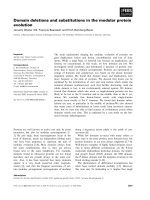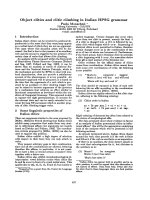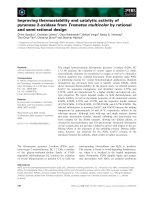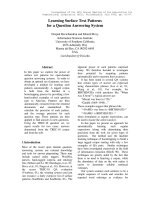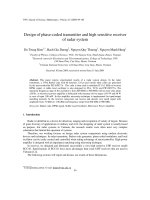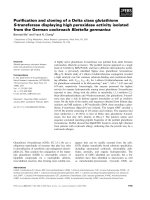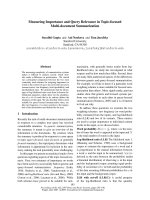Báo cáo "Design of phase-coded transmitter and high sensitive receiver of radar system " doc
Bạn đang xem bản rút gọn của tài liệu. Xem và tải ngay bản đầy đủ của tài liệu tại đây (214.66 KB, 7 trang )
VNU Journal of Science, Mathematics - Physics 25 (2009) 99-105
99
Design of phase-coded transmitter and high sensitive receiver
of radar system
Do Trung Kien
1,*
, Bach Gia Duong
2
, Nguyen Quy Thuong
3
, Nguyen Manh Hung
1
1
Faculty of Physics, College of Science, VNU, 334 Nguyen Trai, Thanh Xuan, Hanoi, Vietnam
2
Research center for Electronics and Telecommunications, College of Technology, VNU
144 Xuan Thuy, Cau Giay, Hanoi, Vietnam
3
Vietnam National University, 144 Xuan Thuy, Cau Giay, Hanoi, Vietnam
Received 10 June 2009; received in revised form 13 July 2009
Abstract. This paper reports experimental results of a radar system design. In the radar
transmitter, a 13-bit Barker code with bit duration 3.24 µs and various other codes are generated
by the microcontroller PIC16F877A. This code is then used to modulate IF 10.3 MHz to become
BPSK signal. A stable local oscillator is also designed by PLL, VCO, and PIC16F877A. The
operation frequency range of the oscillator is from 800 MHz to 900 MHz with an error only about
±10 Hz. A microwave power amplifier is fabricated with structure of two stages of 45 W and 90 W
in case of input 300 mW. In this amplifier microstrip technique is implemented for input/output
matching network. In the receiver, subsystem can receive and decode very small signal with
amplitude from -30 dBm to -108 dBm and frequency range from 800 MHz to 900 MHz.
Keywords: Barker code, BPSK signal, Stable Local Oscillator, Microwave Power Amplifier.
1. Introduction
Radar is identified as a device for detection, ranging and recognition of variety of targets. Because
of great diversity of applications in military and civil, the designing of radar system is usually based
on purpose. For radar systems in Vietnam, the research results were often used very complex
schematics that limited the operation of systems.
Therefore, our working focuses on design radar system components using modern electronic
devices and techniques. In radar transmitter, Barker code generator, phase-coded modulator, and local
oscillator can be easily created and controlled when taking advantage of microcontroller. High power
amplifier is designed with an impedance matching using microstrip technique.
In receiver, we designed and fabricated successfully a very high sensitive UHF receiver model
ECC-01. Specifications of ECC-01 have more advantages than some UHF receivers that are used in
Vietnam [1,2].
The following sections will report and discuss our results of these fabrications.
______
*
Corresponding author. E-mail:
D.T. Kien et al. / VNU Journal of Science, Mathematics - Physics 25 (2009) 99-105
100
2. Experimental
Block diagram of transmitter and receiver of a radar system is shown in the Fig.1. The code used
in the transmitter is the 13 bit Barker code {+++++ ++-+-+}.
Fig. 1. Block diagram of typical radar system.
Reason of choosing Barker codes are auto-correlation function in echo signal pulse compression
process of the Barker code has the magnitude of peak of main-lobe is 13, while the minimum peak of
side-lobe is 1 [3,4]. In some methods used in the past to create the complex codes like Barker codes,
the circuits were unwieldy and needed so many logic gates with uncontrolled of delay time and bits
properties. In our method, the microcontroller PIC16F877A has been selected. The circuit is very
simple and with advantage of microcontroller, any different codes can be easily created.
Technique of phase-coded modulation in this work is binary phase shift keying (BPSK) with the
phase “0” of the IF sine wave represented for bit “1” and phase “π” represented for bit “0”. A IF signal
is taken from the Agilent Signal Generator 8648C with help of a transformer to generate two inverted
sine waves. IC 4052 with 2-line analog multiplexer connect one of the two inverted waves above to its
output depend on logic level of the Barker code at control pin.
Local oscillators in both of the transmitter and the receiver are made from the VCO and PLL
circuits that are controlled by the microcontroller PIC16F877A instead of quality crystals used in other
receivers.
Final stage of the transmitter is the power amplifier. In this module, besides calculation of DC
bias point and stability for high frequency transistor, it is very important to design impedance
matching network using microstrip lines.
The receiver ECC-01 can be able to decode an encoded square wave. In Fig.1, the receiver
includes modules such as RF Wideband Amplifier, RF Mixer, IF Logarithmic Amplifier and Detector.
The IF Logarithmic Amplifier is a non-saturating amplifier which output voltage is linear function of
input voltage for low amplitude signals and logarithmic function for high amplitude signals.
Therefore, a large signal does not saturate the Logarithmic Amplifier. AD6006 is used to make this
amplifier. Good features of the AD6006 are high linearity and large dynamic band enables the
amplifier of ECC-01 can receive UHF signals from -30dBm to -108dBm.
Furthermore, a Timing Automatic Gain Controller (TAGC) is used to enhance dynamic band of
ECC-01. Sawtooth generator sends a negative sawtooth to Gain Control pin of AD6006. Thus gain of
D.T. Kien et al. / VNU Journal of Science, Mathematics - Physics 25 (2009) 99-105
101
the IF Logarithmic Amplifier is adaptively controlled base on amplitude and incoming time of input
pulses.
3. Experiments
3.1 Code generator
The microcontroller PIC16F877A is used to generate any complex code of radar signals. The
Barker code 13 bit {+++++ ++-+-+} created illustratively that shown in Fig.2 with bit duration 3.24
µs, pulse repetition frequency (PRF) 1 kHz. These specifications are suitable for radar applications.
First signal in Fig.2 is clock for synchronizing and second signal is a single pulse for marking the
start of each sequence. Three signals are from three outputs of the PIC16F877A. With zoom function
of Yokogawa DL1720E Digital Oscilloscope 500 MHz, we zoom a bit of the code sequence in third
signal. The zoomed result is shown in fifth signal. Distance between positions of first cursor and
second cursor is exactly 3.24 µs. So the pulse width or width of sequence is 42.12 µs. Fourth signal
and its zoom in sixth signal show edge transition time only 12 ns.
Fig. 2. Barker code 13 bit with bit duration 3.24 µs, PRF 1 kHz.
Advantages of this design using microcontroller are flexibility of changing codes, sequence
properties, bit duration. With crystal 20 MHz used as oscillator for PIC16F877A, a period of an
instruction of microcontroller is 0.2 µs.
Therefore, our circuit can create sequences that have bit duration down to 0.2 µs. This is very
important when people want to create a very short sequence of bits. We knew that when bit duration
and of course code sequence duration is shorter, resolution of radar is higher. It is almost impossible if
use a complicated circuit with a total long time delay of electronic components.
3.2. Phased-code modulator
With the method of BPSK modulation mentioned above [5], we used the Barker code sequence
with bit duration 0.8 µs to control an analog multiplexer IC 4052 of inverted and non-inverted IF sine
waves 10.3 MHz. Signal of BPSK is displayed in Fig.3.
When zooming a part of sequence, we can see approximately 8 periods of IF sine wave inside a
bit time. Start of bit “1” is represented by a phase 0 of sine wave. Start of bit “0” is marked by a phase
D.T. Kien et al. / VNU Journal of Science, Mathematics - Physics 25 (2009) 99-105
102
π of sine wave. Because of delay of some components, we also observe delay of BPSK signal
compare with a bit of sequence.
Fig. 3. BPSK signal of Barker code bit duration 0.8 µs and IF 10.3 MHz.
3.3. Local oscillator
The LM2316 is used with VCO circuit to generate a local oscillator of radar transceiver.
Frequency of local oscillator can change flexibly by data from the microcontroller PIC16F877A push
in 21-bit data register of the LM2316.
In this work, we successfully controlled frequency range from 800 MHz up to 900 MHz. The
signal is analyzed by Advantest Spectrum Analyzer R3131A (Fig.4). Frequency error 10 Hz makes
quality of this oscillator can be compared with that of crystal oscillator.
Fig. 4. Local oscillator at 850MHz.
3.4 Microwave power amplifier
To archive high power gain, amplification needs to divide to some stages. In our schematic, first
stage is in AB mode, second stage is push-pull structure. First stage has high voltage gain but output
power should be medium. Second stage is in inverting strategy. It means low voltage gain but high
D.T. Kien et al. / VNU Journal of Science, Mathematics - Physics 25 (2009) 99-105
103
output power. The first stage we often know as pre-amplifier in microwave power amplification
systems of radar stations [6].
Process of circuit fabrication includes: (1) Calculate and simulate of amplifier specifications using
Smith chart, ADS software. (2) Design PCB use Protel. (3) Fabricate the PCB using ProtoMat C40
PCB Printed Circuit Board LPKF. (4) Add-in electronic components and measure characteristics.
Fig.5 is a photo of experimental amplifier. The first and second stages have output power of 45 W
and 90 W, corresponding, of a standard input 300 mW.
Fig. 6 shows arrangement of facilities in measurement that consists of high quality DC power
supply, Signal Generator SG8550, and Spectrum Analyzer ROHDE & SCHWAR ESPI 9 kHz -3 GHz.
Set a signal 300 mW coming in the amplifier and measure the output by Spectrum Analyzer
ROHDE & SCHWAR ESPI.
Fig. 5. Microwave power amplifier. First stage of 45W, second stage of 90W of an input 300mW.
Fig. 6. Microwave power amplifier setup of measurement.
Fig. 7. Microwave power amplifier measurement.
D.T. Kien et al. / VNU Journal of Science, Mathematics - Physics 25 (2009) 99-105
104
3.5 UHF receiver ECC-01
The ECC-01 has specifications:
- Bandwidth: 6.5 ± 0.5 MHz
- Sensitivity: approximate -90 dBm
- Decoded information voltage: 5 V
- Operating frequency: 800 MHz - 900 MHz
- Input signal level: -30 dBm - 90 dBm
Encoded signal is AM 900 MHz that is created when using Function Generator FG7002C as
external modulating source for AM modulation of Signal Generator SG8550 at frequency 900 MHz.
This signal is fed to the input of the receiver ECC-01. Output of ECC-01 is the decoded signal, that
means square wave of FG7002C, is observed in the Digital Oscilloscope DL1720E (Fig. 9). Level of
encoded signal here is -80 dBm and the modulating level is 99.9%.
Fig. 8. Amplitude characteristic of the microwave power amplifier.
Fig. 9. Decoded signal at 900 MHz, -80 dBm.
4. Conclusion
In conclusion, we summaries some main specifications of the modules of radar system. The main
results are Barker code 13 elements with bit duration 3.24 µs, BPSK signal frequency IF 10.3 MHz,
stable local oscillator 800 MHz-900 MHz with frequency error 10 Hz, high microwave power
D.T. Kien et al. / VNU Journal of Science, Mathematics - Physics 25 (2009) 99-105
105
amplifier with output power can reach 90W and good impedance matching with antenna 50 Ω, and
finally sensitive UHF receiver can receive signal -108 dBm.
In future, we will concentrate on antenna designation, antenna duplexer fabrication. We also want
to build echo pulse compression to improve radar resolution. To raise average pulse power at
transmitter without affect to resolution, we have plan to create intelligent mode of transmission Barker
code 13 bit pulse width 42.12 µs or M code pulse width about 200 µs ÷ 300 µs depend on distance
from radar station to targets near or far.
Acknowledgments. This work was supported by the Department of Radio Physics, Faculty of
Physics, Hanoi University of Science, and the Electronics and Communication Center, College of
Technology, Vietnam National University. The financial is supported by the project QT-09-05 of
Hanoi University of Science, Vietnam National University. We would like to thank for these helps.
References
[1] Lav Varshney, Radar System Components and System Design, Technical Report, Syracuse Research Corporation 2002
[2] Falih H. Ahmad, Design of a High-Resolution, Coded, Portable Radar System, Technical Report, U.S. Army Corps of
Engineers 1996.
[3] August W. Rihaczek, Range Sidelobe Suppression for Barker Codes, IEEE Transactions on Aerospace and Electronics
System Vol. AES-7, No. 6 (1971) c2.
[4] Nadav Levanon, Radar Signals, John Wiley and Sons, Inc., 2004
[5] Werner Wiesbeck, Lecture Script of Radar System Engineering, 2007
[6] David M. Pozar, Microwave Engineering, Second Edition, John Wiley & Sons, Inc., 1998.
